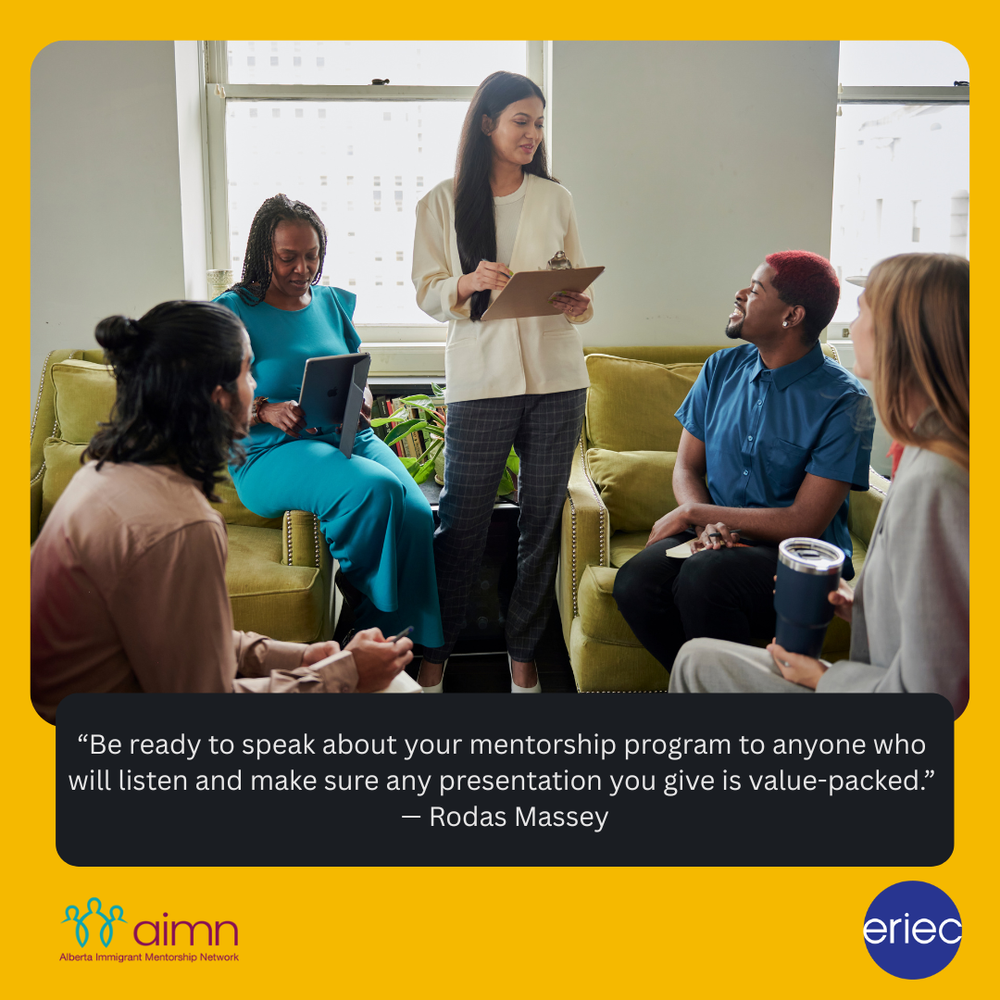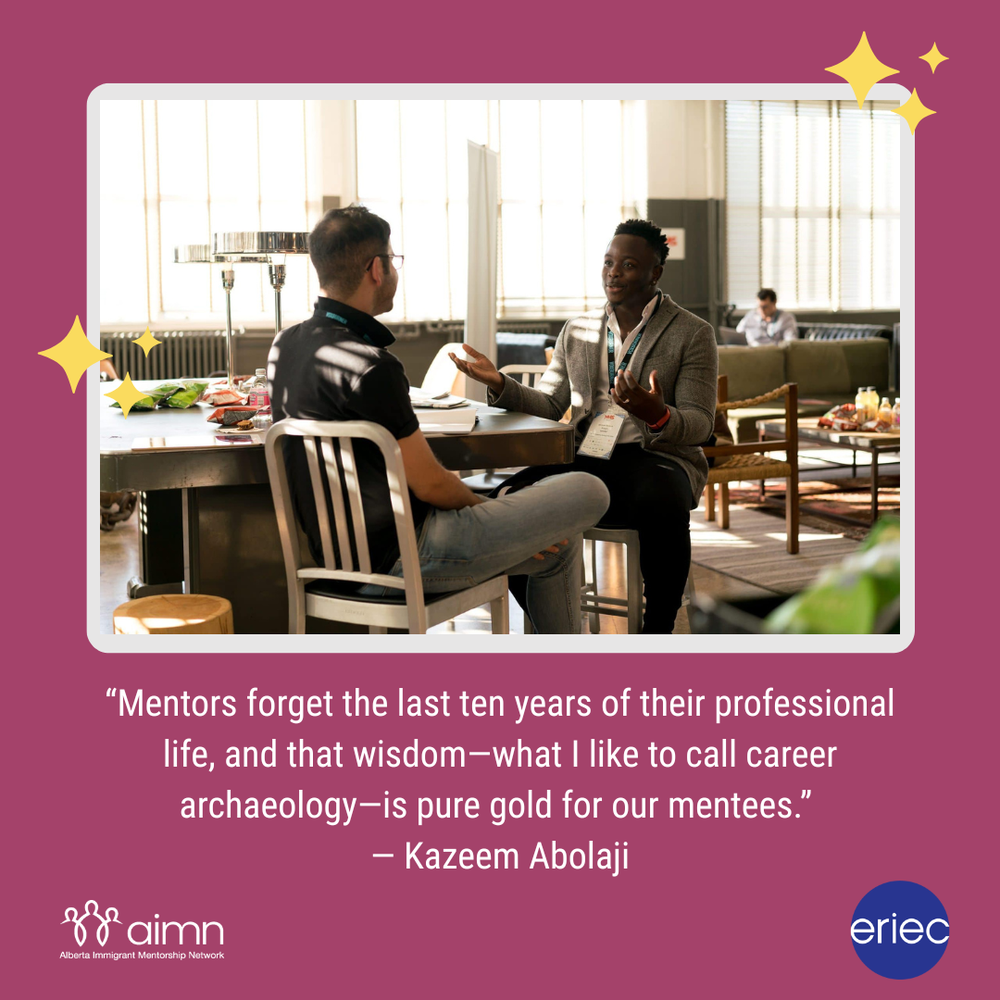On September 5, 2025, the Alberta Immigrant Mentorship Network (AIMN) held an online event featuring strategies on how to attract and recruit mentors in a volatile economy.
Moderated by Cheryl Whitelaw of AIMN and Doug Piquette from the Edmonton Region Immigrant Employment Council (ERIEC), the event welcomed a panel of guest speakers:
- Kayla Atkey, from Edmonton Police Services, who mentors with interVivos
- Kazeem Abolaji from Gateway Association and Mentor Ability
- Pauline Smale from The Family Centre, Edmonton, who mentors with the Edmonton Chamber of Volunteers Organization (ECVO)
- Rodas Massey, from Brooks and County Immigration Services (BCIS)
The panel’s discussion focused on:
- Professional life while mentoring
- Working within the mentoring sector
- Strategies to recruit mentors
- Mentor/Mentee structure
- Mentorship relationship
Navigating Professional Life While Mentoring
Venturing back into the workforce after maternity leave can be daunting, but seeking out areas of mentorship as you move back into your career is strategic and rewarding. InterVivos, an Edmonton-based non-profit mentorship organization, helped guide one panellist, Kayla Atkey, as she began to reorient herself after career and life changes. Beginning as a mentee, Kayla came back to the interVivos’s Interview Business Program years later as a mentor.
Kayla found mentoring just as rewarding as being a mentee. Through their mentorship relationship, Kayla was able to learn different insights and perspectives into her field and enjoyed the two-way dialogue for learning and sharing while watching her mentee grow.
“When you understand what you want from your career and are building it, the process can be quite complex and challenging, so mentorship is a great opportunity to help others through the complexities and barriers they might be experiencing,” states Kayla.
Pauline Smale has similar experiences in giving back to her community by mentoring for the ECVO. As an executive director for 35 years, Smale is a lifelong learner. Mentorship has not only provided her with more learning opportunities professionally and organizationally, but she has also had the opportunity to give back to the community and to enhance the non-profit sector.

“Mentorship has provided me with an opportunity to grow and enhance my understanding of the work going on in the community. I get to learn about some of the gaps, the innovative ideas, the challenges, and the systemic issues that help me in my role in making decisions and thinking systemically,” says Pauline. “So much of my work involves making sense and understanding the environment, which is quite volatile. Mentoring really helps me do my job.”
By mentoring through ECVO, Pauline has helped increase the network of executive directors, which has created a ripple effect by also increasing agencies and the capacity to coordinate and collaborate, allowing the executive director community to become stronger and smarter by collectively addressing the challenges it faces.
Working within the Mentoring Sector
Within mentorship organizations, finding mentors is always a challenge. At MentorAbility, Kazeem Abolaji has noted that the greatest barrier in recruiting high-calibre mentors isn’t the lack of goodwill but unaddressed professional challenges. If these challenges could be reframed, MentorAbility believes mentorship programs could have more success.
The critical challenges MentorAbility has identified and how they’re addressing them include:
1. Liability, expectation, and social fears
Potential mentors are concerned that their mentorship could be misconstrued as a corporate endorsement or could be a reputational liability to their company. They have an anxiety that the mentee expects to get a job at their mentor’s company and worry that they will disappoint their mentee and create an awkwardness going forward in their relationship. To address these concerns, MentorAbility provides its mentors with clear agreements in its training. Mentors and mentees are given set and clear boundaries that focus on the goals of career guidance and network access—not job placement.
2. The myopia of current expertise
Many potential mentors hyperfocus on their current technical skills, believing they can only help people in that industry. They overlook the immense value of their entire career journey.
At MentorAbility, they try to change the conversation regarding expertise myopia by reminding mentors that they have accumulated wisdom as their career journey applies more to the relationship than just their current expertise.
“They forget the last ten years of their professional life, and that wisdom—what I like to call career archaeology—is pure gold for our mentees.” – Kazeem Abolaji
3. Logistical wall
Finding protective time to mentor is difficult when you have a 9 to 5 schedule. Without structure, mentors can face burnout and unsustainable relationships. MentorAbility is currently partnering with employers to find ways to integrate formal and protected mentoring within their work schedule/calendar.
Some of the challenges faced at the BCIS are similar to MentorAbility, but, as Rodas Massey states, some are drastically different because of its rural location. With limited resources in professions due to companies outsourcing their employees or because specific organizations are just outside of BCIS's jurisdiction, finding mentors in specific fields is difficult.
They also face logistical challenges with scheduling. “Many of our mentees are working survival jobs,” states Rodas. “They’re attending the mentorship program to get back into their field, but they have shift schedules that don’t align with their mentor’s schedules, so there is a struggle to find a solution that would fit both mentor and mentee.” They’ve pivoted by using flexibility, allowing mentors from different cities to connect with mentees virtually, or have found mentors who have retired or run their own businesses and can fit mentees in during the daytime.
Being in a rural community, BCIS is one of the first mentorship programs in the area, which offers another unique challenge as they rely on other community program testimonials and resources (such as AIMN) to showcase the power of mentorship.

Strategies to Recruit Mentors
With challenges come opportunities, and BCIS has learned different strategies to help bring mentors and mentees together. “I call it ‘shout from the rooftops, ’” states Massey. “Be ready to speak about your mentorship program to anyone who will listen and make sure any presentation you give is value-packed.” She also recommends reaching out to the busiest people you know because they often carve out time to mentor. Often, such individuals have considered mentoring but needed an outside source to provide the encouragement to do so.
One of the biggest strategies for finding mentors, however, has been communication. As Kazeem states, “You’d be surprised that you have at least five to ten mentors in your network that you haven’t talked to. Talk about mentorship everywhere!”
It’s also important to document the statistics of a mentoring program, when you’re able to, to present to potential mentors. These statistics also allow you to see what works, what can be improved upon, and what can be celebrated.
Mentor/Mentee Structure
Establishing that structure by setting clear outlines, goals, and expectations at the beginning of recruitment can help ease the minds of many mentors. At interVivos, mentors and mentees are given detailed guidelines and principles before they start the mentorship program. As Kayla states, “Both attend an online orientation before the launch, where topics, like job expectations, are raised. After orientation, mentees are given the opportunity to not go through the program.” They also provide check-ins and reminders throughout the program and provide a formal timeline for when mentorship within the program ends. It’s up to the mentor and mentee to continue their relationship afterwards.
“It’s crucial,” states mediator Cheryl Whitelaw, “to have those conversations that are clear about the process and how accessing networks helps.”
With ECVO, Pauline states that they do “a beautiful job of [structuring] because we know what our roles are, and we have that opportunity, ahead of time, to really understand what’s expected of us.” They also have the flexibility to develop a relationship that works best for them. As Pauline says, “I think of these relationships like verbal contracts. We ask what they hope to get out of this and ask how we can shape it so it makes sense for the both of us, and talk about these things upfront.”
Mentorship Relationship
Mentoring isn’t scripted; it’s based on intuitive feedback and natural conversation, creating healthy discussions between the mentor, who asks the questions, and the mentee, who reflects on their knowledge. Being a mentor means providing strategies to help mentees navigate their careers and finding that confidence within themselves by highlighting what they already know.
“A lot of time, it's helping the mentee find their confidence and being that cheerleader for them.” – Doug Piquette
“Mentoring is fundamentally about connection and listening, and often just being a cheerleader. If they’re getting frustrated, they don’t need answers; they just need someone to talk it out with. And I don’t have to have the answers,” states Annette Wierstra. “They get something out of it more than I think I’m giving, but that’s good. So, I don’t have to define the value they get. The experience of mentoring is so valuable than the intellectual thought of it.”
Being a mentor means building a relationship in a private, often informal setting. It’s also about embracing your vulnerabilities and understanding that many people walking into this role often feel they lack the necessary knowledge or experience, but, as Doug states, “wearing vulnerabilities on your sleeve is part of the leadership journey, and if you’re able to embrace that, that’s a position of power. It’s recognizing that you still have lots to learn from everyone you encounter, even with the amount of experience you have, and that, to me, is part of the recipe in becoming a good leader.”
The Alberta Immigration Mentorship Network is sponsored by the Edmonton Region Immigrant Employment Council (ERIEC).
The Alberta Immigration Mentorship Network is appreciative of the funding from the Edmonton Community Foundation, Workforce Strategies. Our program is here to provide information and support to help organizations start mentorship programs.